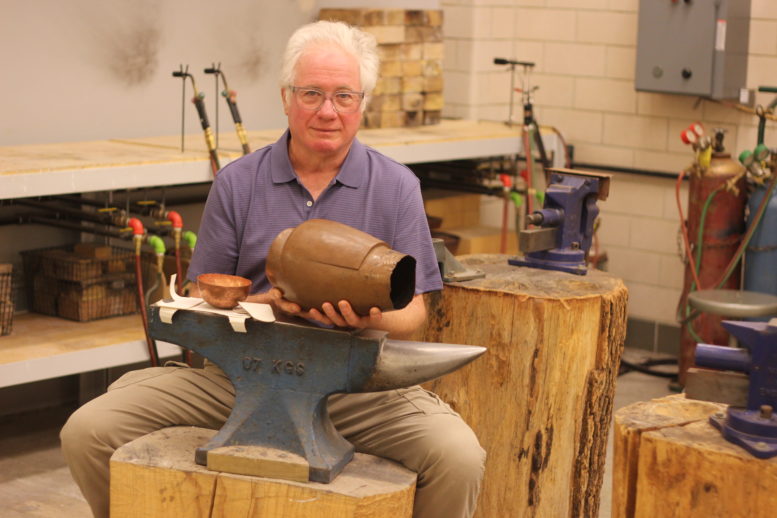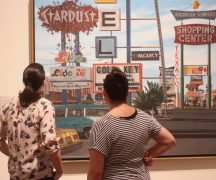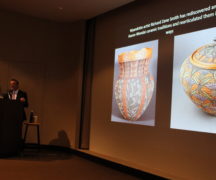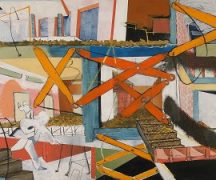By DAVID DUPONT
BG Independent News
It has taken 30 years for Tom Muir’s “Cycladic Figure Impregnated” to find a home.
The metal coffee server, one of the silversmith’s signature works, could have entered the White House collection of American Crafts. Instead that institution received a vessel inspired by Beluga whales. And it was one of the two works being considered by the Institute of Art of Chicago. That collection got the first in the series of these fertility figures though.
Muir has had private collectors offer to buy it, but the price wasn’t right, and he kept it close to home.
Now the 30-year-old vessel has found its place in the collection of the Toledo Museum of Art.
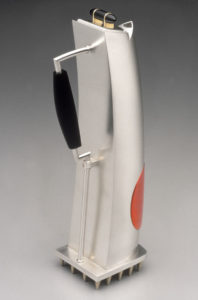
Tom Muir’s “Cycladic Figure Impregnated”
“This was always one of my favorite pieces,” he said. The piece is made of 18-carat gold, sterling silver, oxidized copper and anodized aluminum. “I wanted it to have red belly to make it alive.”
The base is shaped like udders. “It was a more interesting way to present it.”
The museum has been holding the piece for several years, said Muir, a Distinguished Professor of Art at Bowling Green State University.
The intent was to purchase it when the proper arrangements could be made. Jutta Page, then curator of glass and decorative art at the museum, contacted him earlier this year, to start the purchase process.
Now the executive director of Old Dominion University’s Barry Art Museum, Page said she was pleased that the museum completed the purchase.
In an email, she described “Cycladic Figure Impregnated” as “a significant American contemporary work by this much-revered local artist, nationally recognized metalsmith, and influential teacher to many a generation of BGSU students.”
She added: “It is gratifying for me to know that this object will be preserved in a public collection.”
Completing the transaction meant determining the purchase price, which has not been disclosed.
Muir makes it clear that he does not donate his work. Some artists do, he said, just so they can say they have work in a certain collection. “They’re cutting their own throats and others’ throats,” he said. He’s had purchase offers that barely cover the cost of the $2,000 in metals that were used to make the piece.
Even in 1993 when the White House social secretary called about Muir contributing a piece to start the American craft collection, he said he couldn’t donate it.
Instead BGSU purchased the piece so it could go into the collection, and the university would benefit from the recognition.
Muir researched pieces comparable to his and found out what they sold for at auction. He determined the value from that. Then the museum paid half that price.
It was the same process when the Art Institute purchased “Cycladic Figure with His Hair in a Roller,” the first piece in this series.
Muir started the series of vessels inspired by fertility figures when he was completing his graduate work at the University of Indiana. He’d been working on brooches, as models for larger work. His love, though, was for making vessels. He attended an art history lecture on fertility figures from the Cyclades, Greek Islands in the Aegean Sea. The figures date back to 3200 BC.
Muir, who minored in art history, saw a connection between these figures and the vessel he was working on.
And because of the way the spout looked, his gave it the whimsical title “Cycladic Figure with His Hair in a Roller.” His professors and fellow students hated that title, he noted. But it reflected his sense of humor, an element he felt was important. The completed piece encompassed all he was trying to achieve.
“For me part of the attraction was the challenge in creating utilitarian work that incorporates my aesthetic interest in utility and engineering,” Muir said. The engineering involves both the fabrication of the material, and then assuring that the vessel works.
Muir is proud of that fact that if someone decided to use his piece as a coffee pot, it would pour properly. The key, he said, is the paper-thin metal skin.
Muir has been attracted to vessels since he started making them in his first silversmithing class. Taking a sheet of metal and creating a cylinder came naturally to him.
The “Cycladic Figure Impregnated” and the others in the series, also make reference to art history.
“I try to think of all my works as an ecosystem,” he said. “I work different things into them.”
He compared it to keeping his pond on his Perrysburg homestead healthy. “The more forms of life you have, the more variety, the healthier the environment.”
Muir, 60, employs that thinking to his approach to his studio at BGSU, where he has taught since 1991.
He has his students work in enamels, blacksmithing, vessel fabrication, and casting.
He does not shy away from the concept of craft. He takes pride in working within the strictures of the discipline.
His pieces are “not sculpture,” Muir insists. “It’s sculptural, but not sculpture. This vessel relates to the whole history of vessel making. It venerates the craft in a positive way.”
Page echoed that assessment of “Cycladic Figure Impregnated.”
“His self-imposed artistic rigor and skilled expertise resonate in the highly sophisticated craftsmanship of this exquisite, sculptural vessel.”
Of late Muir has stepped away from vessels. Using digital modeling, he’s been concentrating on belt buckles, and won the World Champion Belt Buckle Competition. (See http://bgindependentmedia.org/tom-muir-wins-the-championship-belt-for-best-buckle/) He’s planning to work on codpieces next.
Still he expects to return to vessels. They have deep resonance as womb-like containers for life. “Vessels,” he said, “are the most basic and accessible of art forms.”

